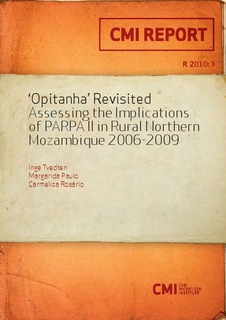| dc.contributor.author | Tvedten, Inge | |
| dc.contributor.author | Paulo, Margarida | |
| dc.contributor.author | Rosário, Carmeliza | |
| dc.date.accessioned | 2010-04-05T03:41:50Z | |
| dc.date.accessioned | 2017-03-29T09:13:16Z | |
| dc.date.available | 2010-04-05T03:41:50Z | |
| dc.date.available | 2017-03-29T09:13:16Z | |
| dc.date.issued | 2010 | |
| dc.identifier.isbn | 978-82-8062-388-1 | |
| dc.identifier.issn | 1890-503X | |
| dc.identifier.uri | http://hdl.handle.net/11250/2436085 | |
| dc.description.abstract | This report is part of a larger exercise of monitoring and evaluating Mozambique’s poverty reduction strategy, focussing on three districts in Mozambique and using a combination of quantitative and qualitative data. It analyses the constitution and dynamics of poverty and well-being in the rural district of Murrupula in the Nampula Province, by revisiting four local communities and a total of 120 households three years after our first visit in 2006. While a number of improvements have taken place in local governance, physical infrastructure and agricultural marketing options, this has so far primarily benefitted the better-off with few if any implications for the very poorest. | |
| dc.language.iso | eng | |
| dc.publisher | Chr. Michelsen Institute | |
| dc.relation.ispartofseries | Research report | |
| dc.relation.ispartofseries | R 2010: 3 | |
| dc.subject | Mozambique | |
| dc.subject | Poverty | |
| dc.title | 'Opitanha' revisited. Assessing the implications of PARPA II in rural northern Mozambique 2006-2009 | |
| dc.type | Research report | |
